|
Seventh Cavalry

Plains
Indians

Articles

Booklets

Book
Reviews

Links

Message
Boards

Blog

Home

Questions?

©2004-2017
Diane Merkel
Reproduction
in whole or in part without prior written consent is prohibited.
|
Little
Big Horn Associates Research
Myles
Walter Keogh
Narrative
and Photographs by Elisabeth Kimber
The
Memorial Stone •
This is in a pretty little memorial garden (created
as a millennium commemoration) in Keogh's home town
of Leighlinbridge, County Carlow, Ireland. The garden
is close by the river, just across the bridge (which
you'll see later) from the town. There are also stones
and sculptures commemorating other famous sons of
the town; for its size, it's produced a surprising
number. An archbishop, a leading scientist, all sorts.
The plaque reads:
The
Colonel from Leighlin who died in
one of the greatest battles to grip the
public imagination,
The Battle of the Little Big Horn
or what became known as
Custer's Last Stand.
|
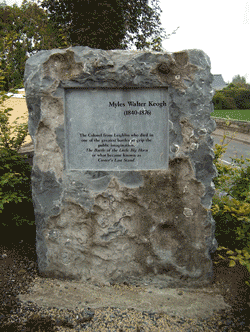 |
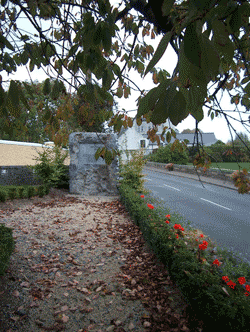
|
The Town of Leighlinbridge •
The
bridge itself is, I think, said to be the oldest
in Ireland, built by King Richard II. (If I remember
correctly.) Known as "the valerian bridge"
because of the valerian growing out of the stonework.
Very pretty. The small castle you see at its far
end was a British garrison during the 1798 rising
(in which Keogh's uncle was executed by the British
-- unjustly, as he hadn't been an active rebel)
and for some years after. It's tempting to think
that little Myles might have watched the troops
clattering by in their gorgeous uniforms, and that
this is what made him want to be a soldier! (Though
not for the wicked British, of course, after what
they did to Uncle Patrick.)
|
|
The rather grand gateway to Orchard, Leighlinbridge, the
house where Keogh was born •
The
driveway curves on for another quarter-mile or so, then
there's a cattle-grid and a gate that (on the day I went)
was very firmly tied shut with baler twine . . . so I kind
of got the message that casual callers weren't invited.
Pleased I did, as I later learned that there'd been illness
in the family (yes, still the Keoghs! -- though they've
changed the spelling to Kehoe now) and it would have been
tactless to go barging in. It was enough of a delight to
catch this glimpse of the place: a lovely, comfortable-looking
old stone farmhouse with a pretty walled garden, set in
gently rolling pastureland. Great horse country. Easy to
imagine Keogh, as a boy, galloping his pony hell-for-leather
across the fields, leaping hedges and ditches. . . .
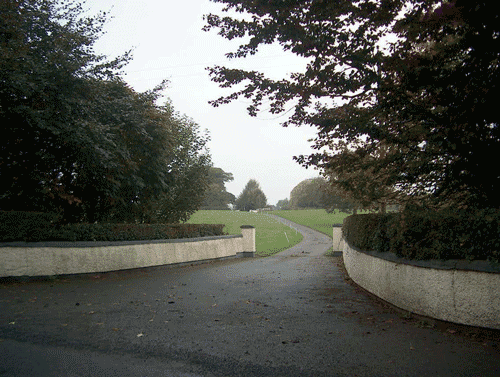
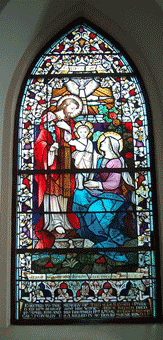 |
The
Stained-glass Window
This
is in the church at Tinryland, a village about 10
(?) miles from Leighlinbridge, where Tom, Keogh's
brother, made his home. (Their eldest brother, Patrick,
took over Orchard after their mother's death.) I don't
know for sure, and the priest wasn't around to ask
when I visited, but I imagine it would have been Keogh's
sister Margaret who commissioned the window. It's
a tiny church, very plain, so this window and another
companion Keogh family one really make a splash. Nice.
The
bottom reads:
ERECTED
TO THE MEMORY THOMAS KEOGH •
PARK •
DIED 15TH AUGUST 1897 HIS WIFE ALICE
KEOGH DIED
21ST
APRIL 1875 AND HIS BROTHER BVT LTCOL
MYLES W KEOGH
CAPN 7 CAVALRY USA KILLED IN ACTION 25TH
JUNE 1876 RIP
|
The
even grander gateway to Tom's house, Park, Tinryland
• More
driveway-creeping! (I felt like a burglar. It's a wonder
I wasn't arrested!) While Orchard is a really nice, big,
rambling stone farmhouse, and looks to be a very comfortable
family home, Park is -- as far as I could see -- a little
grander. Not in the "stately home" bracket, but
a little bigger than Orchard. I was told that Keogh's sabre
and saddle are there!!! So I presume the present inhabitants
are a branch of the family. Again, a very prosperous-looking
farm; and its main business now is, believe it or not, fruit
juices and fruit smoothies -- Park is the headquarters of
Sunshine Juices. Supplies the whole of Ireland. An enterprising
family, these Keoghs. ---- About a mile down the road from
here is the site of the old Ballybar racecourse, which would
have been at the height of its fame when Tom was living
there. Must have made for some very entertaining times when
Keogh was on his home leaves.
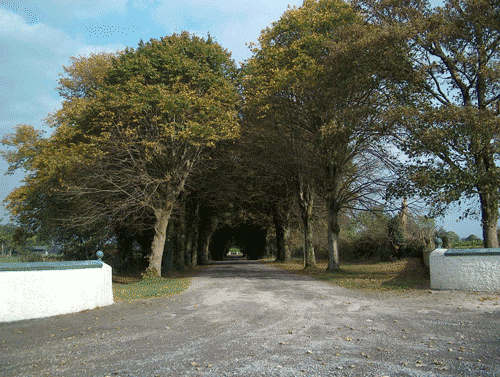
(Something very sweet: I got hopelessly lost looking for
Park, and had to ask for directions in the village shop
. . . and the shopkeeper chatted away about Keogh's last
visit as if it had been only days ago, not 130 years!)
©2005
Elisabeth Kimber

Funeral
(copied from the New York Army & Navy Journal)
We extract from the Auburn papers the following accounts
of the burial of the late Col. Myles W. Keogh, at Fort Hill
Cemetery, Auburn, NY. Oct 26: Promptly at 2pm the funeral
procession moved from the St James Hotel, where the pallbearers
had assembled, and marched in the following order: The Pall-Bearers;
Auburn City Band; Military, Lt. Judge, commanding; Post
Crocker, G.A.R.; Post Seward G.A.R.; Hearse, draped with
the National colors; Carriages bearing the family of E.
T. Throop Martin and Army officers. A detail from Post Seward
fired minute guns during the march and the ceremonies at
the grave. The flag at the State Armoury was flown at half-mast,
as were numerous other flags about the city. Volunteers
from the several Auburn organisations of the 49th NY Militia
were formed into a company, charged with the duties of escort
and firing party, according to military etiquette. At the
receiving vault the casket was draped with the American
flag, upon which were placed some beautiful floral designs.
The bearers then placed the casket in the hearse and the
line moved to the grave on the lot of E.T. Throop Martin
Esq. The pall-bearers were Gen. W. H. Seward, Col. C.C.
Dwight, Col. J. E. Storke, Col. E.D. Woodruff, Surgeon Theo.
Dimon, Major L.E. Carpenter, Major W.G. Wise and Capt. W.M.
Kirby. The following officers of the regular army were present:
Gen. L.C. Hunt, Col. R.N. Scott, Surgeon R.N. O'Reilly,
Gen. A. J. Alexander, Lieut. J.W. Martin. The grave was
laid with evergreens and flowers, and at its head, the base
of a handsome monument to be erected in memory of this dead
soldier, was strewn with other floral tributes. The remains
were lowered into the grave, when the solemn burial service
was read by Rev. Dr. Brainard. A dirge was then executed
by the band, after which three volleys of musketry were
fired by the military, and the procession marched from the
cemetery in the same order as on its entry, the immediate
friends remaining until the grave was closed. The obsequies
were most solemn and imposing, and in every way befitting
the rank and record of the fallen brave in whose honour
they were held.
|
|